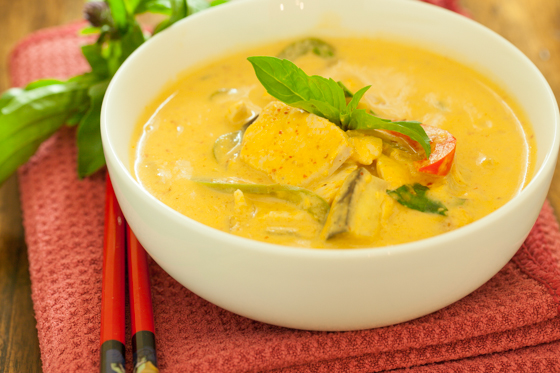
I love Thai food. I have been known to take Thai leftovers home from a dinner out and eat them in the morning for breakfast. Who says you can’t have curry for breakfast? Hey, I like what I like. I can’t explain it. Below is additional information about this recipe and the ingredients in it. If you’re not familiar with some of the ingredients, the info below should help guide you.
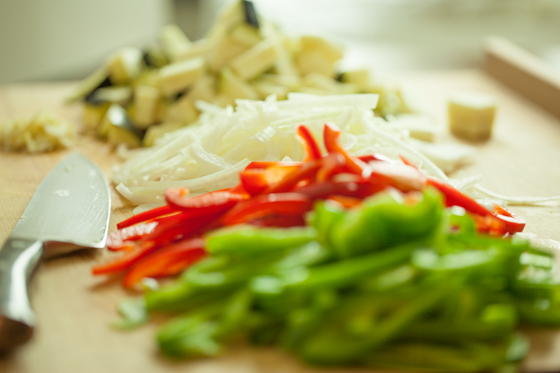
Chicken. When I start cooking this recipe, I first pop the chicken breasts in the freezer. I like them sliced really thinly for this recipe, and that’s much easier to do with a partially frozen breast (and a nice sharp chef’s knife). I take them out and slice them just before tossing them in the curry to cook.
Curry paste. If you’ve never bought curry paste before, look for it in the international or Asian aisle at the supermarket. You can also find it at any Asian supermarket. Make sure and read the ingredients on the label and watch for peanut or soy. (Since I’m not hyper-sensitive, the curry paste I bought was produced in a facility that also deals with peanuts, but there were no peanuts or peanut products in the paste.) I used Maesri brand red curry paste and it was spicy! It definitely was NOT too hot to eat for my taste, and I’m not into crazy-hot or that it’s-so-hot-I-can’t-taste-my-food kind of heat. Bottom line: if you don’t enjoy spicy food, I recommend you buy a less spicy paste. You could also sub red curry paste for green, yellow, or whatever is your favorite.
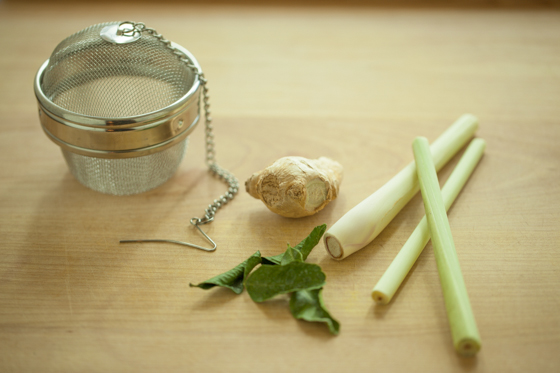
Spice ball, kaffir lime leaves, ginger root, and lemongrass
Ginger. For this recipe you don’t have to worry about peeling it! You don’t end up eating it, it just flavors the broth and is then removed. So save yourself the work. But in the future if you have to peel ginger, it’s easiest to do it with a spoon. Yes, a spoon! The skin peels off easily, and the spoon gets around any little bump or groove of the ginger root.
Kaffir lime leaves. You can find these fresh in the produce section of the grocery store where you find all the other herbs. They are also sometimes available dried in the Asian aisle. If you buy them fresh you’ll get more leaves in the package than you need for the recipe. Don’t waste the leftovers; pop them in the freezer in the plastic container they came in. They’ll keep for months. If you can’t find kaffir lime leaves, simply substitute this ingredient for lime zest. By using a vegetable peeler, you can get big slices of zest to toss in for cooking and fish out later before serving.
Lemongrass. Lemongrass can be found fresh in the produce section. If it is available in single stalks, you’ll only need one stalk for this recipe. If you find it packaged in plastic containers near other packaged herbs as I did, you’ll need two pieces, which is equivalent to 1 long lemongrass stalk. To release flavor from the lemongrass, slice it into chunks and pound it on the back of your knife, as you would a garlic clove, to bruise it a little and allow it to really release flavor. If you can’t find lemongrass, you can just leave it out. Most curry pastes have ground lemongrass in them, so you should still get some of that flavor.
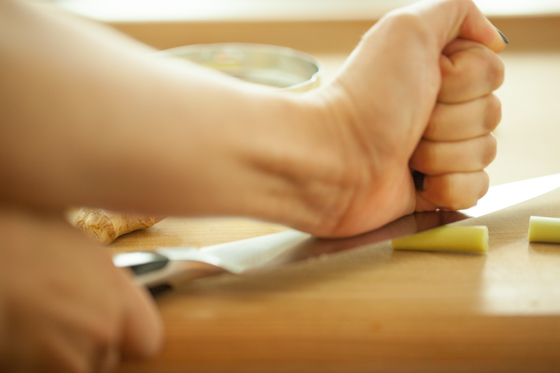
Spice ball. You don’t actually eat the lemongrass, kaffir lime leaves, or ginger. Similar to how you use a bay leaf, you pull them out just before serving. At most Thai restaurants you might find these in your dish, and you just pull them out as you eat. I like to use a spice ball so I don’t have to worry about chomping down on a big piece of ginger. I place the lemongrass, kaffir lime leaves, and ginger into the spice ball. I even leave it in when I pack up my leftovers to allow the flavors to maximally infuse the curry. Whether you have a spice ball or not, you can make this recipe. Just be sure you don’t try and eat a big hunk of one of these ingredients.
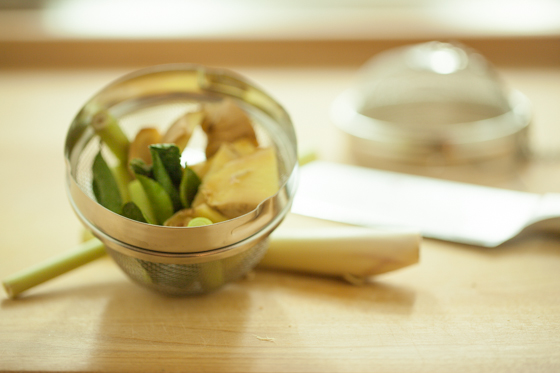
Coconut milk. When you’re buying canned coconut milk make sure and read the ingredients list. As discussed in my Make Your Own Almond Milk post, coconut milk can also have thickeners added to it. These thickeners are usually legume based, and therefore not paleo. Unlike almond milk, it’s very easy to find coconut milks that contain only coconut meat and coconut water. All you have to do is read the label. The most common one added you want to avoid is guar gum. You can find coconut milk in the Asian aisle of the grocery store. If you go to an Asian supermarket, you’ll find more types of coconut milk than you knew existed! Sometimes I have a hard time finding “clean” coconut milk (without thickeners) at generic grocery stores. Higher end or healthier stores definitely carry clean coconut milk brands, I believe Trader Joe’s is just coconut meat and water (even though it’s “light”), and you can always order “clean” coconut milk brands online. If you’ve found a “clean” brand you like, you can share it for other readers in the comments at the bottom of the page.
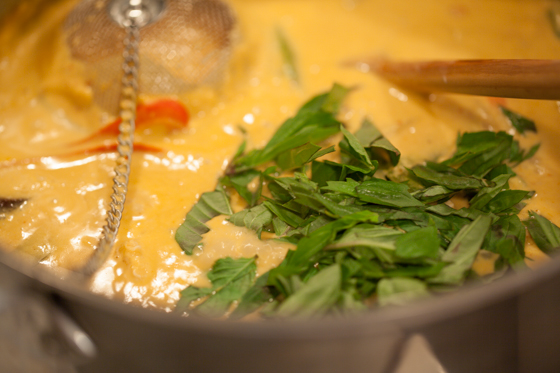
Thai chilies. I didn’t use Thai chillies in this recipe because I shopped on this occasion at my regular grocery store and they don’t carry them. I usually find them at an Asian grocery store. It worked out just fine because the curry paste I used turned out to be just the right amount of hot for me (but again, warning for not-spice-lovers: it was hot). If you want to add more heat to your curry start by adding in 1-2 (red or green) Thai chillies during step three. You can include them in your spice ball if you want cause you don’t want to eat them (unless you’re practicing for your Man vs. Food audition). If you want to live like a true Thai, plan on adding 8-12 chillies. Yes, that’s what they did in my cooking class in Bangkok, Thailand. Yikes!!
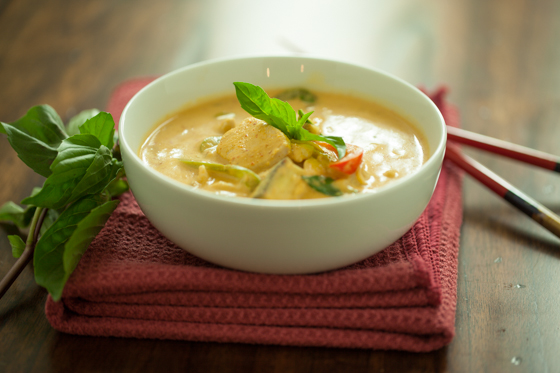
You can serve this recipe as a soup (shown above), or you can make and serve it over Basic Cauliflower Rice. A good rice variation would be to use lime and thai basil. Or, you could go super simple and just boil the cauliflower in broth or stock (with or without garlic), and just season it with salt and pepper.
- (1) 4 ounce can of Red Curry Paste
- 2 cloves garlic, minced
- (4) 13.5 ounce cans coconut milk
- 1 cup chicken broth
- 1 onion, sliced thinly
- 1 small eggplant, diced
- 1 stalk lemongrass, sliced and pounded
- 6 kaffir lime leaves
- 2 inch cube of ginger, sliced
- 1 pound chicken breast, sliced thinly against the grain
- 1 red bell pepper, cored and thinly sliced
- 1 green bell pepper, cored and thinly sliced
- (1) 0.75 ounce package Thai basil, roughly chopped.
- Heat a large pot over medium heat. Add curry paste, garlic, and a few splashes of coconut milk. Cook about 2 minutes, stirring to combine.
- Whisk in the rest of the coconut milk and the chicken broth.
- Add lemongrass, kaffir lime leaves, ginger, eggplant, and onion. Boil for 10 minutes.
- Stir in chicken, red peppers, and green peppers. Cook for 6 more minutes (or until the chicken is just cooked).
- Just before serving, stir in Thai basil.
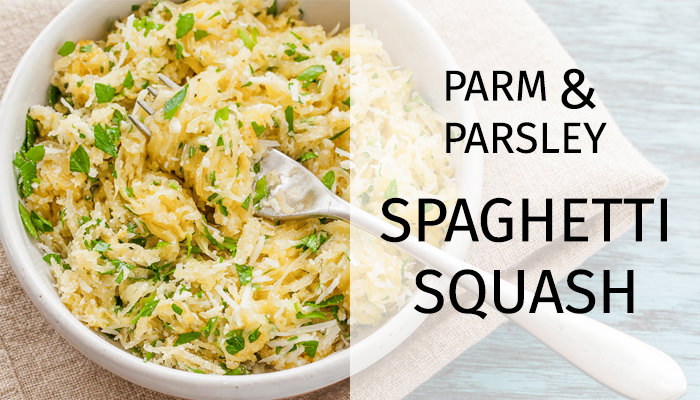
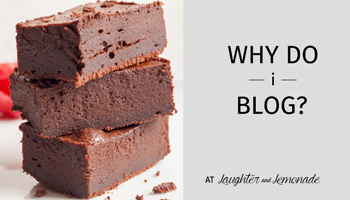
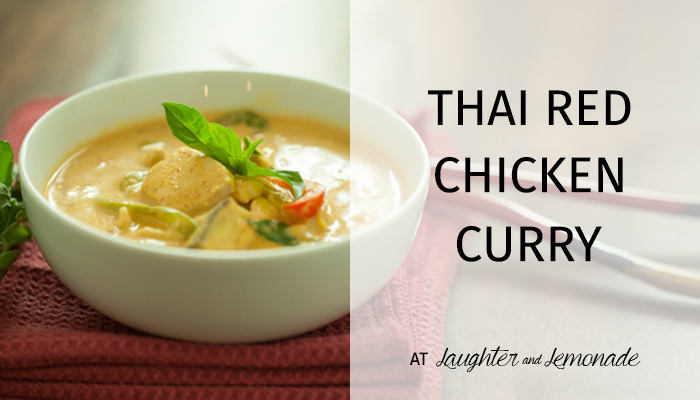

My wife and I made this recently.. It was delicious and quite easy to prepare!
Thanks for the great feedback, Tyler. So glad you both enjoyed it! It’s perfect for the weather we’ve been having. 🙂
Can this recipe be made into a crockpot to have leftovers for the week?
Hi Jane, I have never tried it in a crock pot before… I would imagine it could work. If you try it let us know how it turns out!